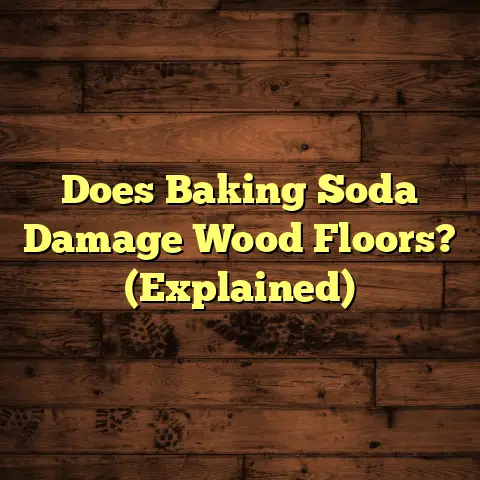Fill Floor Hole Around Pipe? (4 Urgent Seal Tips!)
Have you ever stared at that ugly gap around a pipe snaking
through your floor, wondering how to make it disappear?
It’s more than just an eyesore.
It’s a potential entry point
for pests, moisture, and drafts.
Let’s dive into how to fix it!
Section 1: Understanding the Problem
So, what exactly is a floor hole around a pipe?
It’s that
annoying gap, often circular or irregular, where a pipe
(usually plumbing or heating) passes through your flooring.
These holes pop up for a few reasons:
-
Plumbing Renovations: When pipes are moved or replaced, the original hole might be too big for the new setup.
-
Old Installations: Older homes might have had less precise drilling techniques, leaving larger gaps.
Wear and Tear: Over time, the flooring material around the pipe can degrade, creating or widening the hole.
I’ve seen this happen a lot with old linoleum or brittle tile.
You’ll find these in bathrooms, kitchens, basements – really,
anywhere pipes run.
I’ve even seen them in commercial
buildings, hidden behind equipment or in storage areas.
Leaving these holes unaddressed is a bad idea. Here’s why:
Water Damage: Moisture can seep in, leading to rot, mold, and structural damage.
According to the EPA, mold growth can start within 24-48 hours of water exposure.Pest Intrusion: Mice, insects, and other critters can squeeze through these openings.
I once had to deal with a massive ant infestation that started from a tiny gap around a drain pipe!Energy Inefficiency: Drafts can make your heating and cooling systems work harder, increasing your energy bills.
The Department of Energy estimates that air leaks can increase energy bills by 10-20%.
Beyond the practical problems, let’s be real: it looks bad.
An unkempt appearance can affect your mood and even impact
the value of your property.
No one wants to see a gaping hole
in their floor!
Section 2: The Importance of Sealing Floor Holes
Sealing those holes isn’t just about aesthetics; it’s about creating a safe, efficient, and healthy environment.
Think of it like this: your flooring is a barrier.
When that
barrier is breached, all sorts of problems can sneak in.
Effective sealing helps:
Prevent Moisture Intrusion: A good seal prevents water from seeping under your flooring, protecting the subfloor and preventing mold growth.
I always tell clients, “An ounce of prevention is worth a pound of cure” when it comes to water damage.Improve Energy Efficiency: By blocking drafts, you’re reducing heat loss in the winter and keeping cool air in during the summer.
This can translate to significant savings on your energy bills.Enhance Aesthetic Appeal: A clean, sealed floor looks much better than one with unsightly holes.
It shows that you care about your home and its upkeep.
I’ve seen firsthand the difference sealing can make.
I worked
on a project in an old Victorian house where the floors had
numerous gaps around pipes.
After sealing them, the homeowners
reported a noticeable decrease in their heating bills and a
reduction in drafts.
They were also thrilled with how much
better the floors looked!
A study by the National Association of Home Builders found that
proper sealing and insulation can reduce energy costs by up to
15%.
That’s a significant saving that makes sealing those holes
well worth the effort.
Section 3: The Right Materials for Sealing
Okay, so you’re convinced you need to seal those holes.
The next step is choosing the right material.
Here’s a
rundown of common options:
Caulk: This is a flexible sealant that comes in tubes and is applied with a caulking gun.
It’s good for smaller gaps and comes in various types (acrylic, silicone, latex).- Pros: Affordable, easy to use, paintable (depending on the type).
- Cons: Can shrink or crack over time, not suitable for large gaps.
Expanding Foam: This comes in a can and expands to fill gaps.
It’s great for larger holes but can be messy.- Pros: Excellent for filling large, irregular gaps, good insulation properties.
- Cons: Can expand too much and make a mess, not paintable, can be difficult to control.
-
Concrete Patch: Used for concrete floors, this is a mixture of cement, sand, and aggregates.
- Pros: Durable, strong, good for repairing concrete.
- Cons: Only suitable for concrete, can be difficult to work with, requires mixing.
Putty: A moldable substance that can be used to fill small gaps.
Plumber’s putty is specifically designed for sealing around pipes.- Pros: Easy to mold and shape, good for small gaps, waterproof.
- Cons: Not as durable as other options, can dry out and crack over time.
Here’s a quick comparison table:
Choosing the right material depends on the size of the hole,
the type of flooring, and your skill level.
For a small gap
around a pipe in a tile floor, I’d recommend caulk.
For a
larger hole in a concrete floor, concrete patch is the way to
go.
Section 4: Step-by-Step Guide to Filling Floor Holes Around Pipes
Alright, let’s get down to the nitty-gritty.
Here’s how to
fill those holes like a pro:
Step 1: Assess the Size and Shape of the Hole
Take a good look at the hole.
Is it small and round?
Large
and irregular?
This will help you determine the best material
to use.
Step 2: Select the Appropriate Sealing Material
Based on your assessment, choose the right material.
Remember
the pros and cons of each option.
If you’re unsure, it’s
always better to go with a more durable option.
Step 3: Prepare the Area by Cleaning and Drying the Hole
This is crucial!
Remove any loose debris, dirt, or old sealant.
Use a brush or vacuum to clean the area thoroughly.
Then, make
sure it’s completely dry.
Moisture can prevent the sealant
from adhering properly.
Step 4: Apply the Sealing Material, Ensuring a Tight Fit Around the Pipe
Caulk: Load the caulk into a caulking gun.
Cut the tip at a 45-degree angle.
Apply a bead of caulk around the pipe, making sure to fill the gap completely.
Smooth the caulk with your finger or a caulk smoothing tool.Expanding Foam: Shake the can well.
Apply the foam sparingly, as it will expand.
Allow it to dry completely, then trim off any excess with a utility knife.Concrete Patch: Mix the concrete patch according to the manufacturer’s instructions.
Apply it to the hole with a trowel, making sure to fill the gap completely.
Smooth the surface with the trowel.Putty: Mold the putty into a rope shape.
Wrap it around the pipe and press it into the gap.
Smooth the surface with your finger.
Step 5: Finish the Surface to Match the Surrounding Flooring, if Necessary
If you’re using caulk or concrete patch, you may need to paint
or stain it to match the surrounding flooring.
This will help
the repair blend in seamlessly.
Pro Tip: Use painter’s tape to create clean edges.
Apply
the tape around the hole before applying the sealant.
Remove
the tape immediately after smoothing the sealant.
This will
give you a professional-looking finish.
Section 5: 4 Urgent Seal Tips for Effective Results
Okay, you’ve got the basics down.
Now, let’s talk about some
urgent tips to ensure your sealing job is top-notch:
1. Tip #1: Always choose the right sealant for the specific material of your flooring.
This seems obvious, but it’s crucial.
Using the wrong sealant
can lead to adhesion problems, cracking, and ultimately, a
failed seal.
For example, using a latex caulk on a wet
concrete floor is a recipe for disaster.
2. Tip #2: Allow adequate curing time to ensure the seal is effective and durable.
Patience is key!
Sealants need time to cure properly.
Check
the manufacturer’s instructions for the recommended curing
time.
Don’t rush the process.
I’ve seen people ruin their
work by using the area before the sealant was fully cured.
3. Tip #3: Regularly inspect sealed areas to catch any signs of wear or deterioration early.
Make it a habit to check your sealed areas periodically.
Look
for cracks, gaps, or signs of water damage.
Catching problems
early can prevent them from escalating into bigger, more
expensive repairs.
4. Tip #4: Don’t skip the finishing touches—ensure the repair blends well with the existing flooring for a seamless appearance.
A little bit of effort can go a long way.
Painting or staining
the sealant to match the surrounding flooring can make the
repair virtually invisible.
This is especially important in
high-traffic areas or where aesthetics are a priority.
Section 6: Common Mistakes to Avoid
Even with the best intentions, it’s easy to make mistakes when
sealing floor holes.
Here are some common pitfalls to avoid:
Using the Wrong Materials: As I mentioned earlier, choosing the wrong sealant can lead to problems.
Make sure you select a material that is compatible with your flooring and suitable for the size of the gap.Neglecting to Clean the Area Properly: Dirt, debris, and moisture can prevent the sealant from adhering properly.
Always clean and dry the area thoroughly before applying the sealant.Rushing the Application Process: Take your time!
Applying the sealant too quickly can result in a messy, uneven finish.
Work slowly and carefully to ensure a tight, even seal.Overlooking Ventilation: Some sealants release fumes during the curing process.
Make sure to ventilate the area well to avoid inhaling these fumes.Not Wearing Protective Gear: When working with sealants, it’s important to wear gloves and eye protection.
Some sealants can irritate the skin or eyes.
Solution: If you make a mistake, don’t panic!
Remove the
sealant immediately and start over.
With a little patience
and attention to detail, you can achieve a professional-looking
finish.
Section 7: FAQs About Sealing Floor Holes
Let’s tackle some frequently asked questions:
What should I do if the hole is too large?
If the hole is very large, you may need to use a combination
of materials.
Start by filling the bulk of the hole with
expanding foam, then cover the foam with a layer of concrete
patch or caulk for a smooth, finished surface.
How can I tell if my sealant is failing?
Look for cracks, gaps, or signs of water damage.
If you notice
any of these, it’s time to replace the sealant.
Can I use the space immediately after sealing?
It depends on the sealant.
Check the manufacturer’s
instructions for the recommended curing time.
Avoid using the
area until the sealant is fully cured.
Is it okay to just cover the hole with tape?
No.
Tape is a temporary fix at best.
It won’t prevent moisture
intrusion or pest infestation.
You need a proper seal to
protect your floor.
What if the pipe moves or vibrates?
Use a flexible sealant like caulk or plumber’s putty.
These
materials can accommodate movement without cracking.
Conclusion
Sealing floor holes around pipes is a simple but important
task.
By taking the time to do it right, you can protect your
home from water damage, pests, and energy loss.
You’ll also
improve the appearance of your floors and create a more
comfortable living space.
Don’t let those unsightly holes linger any longer.
Grab the
right materials, follow these tips, and restore your floors to
their former glory.
You’ve got this!





